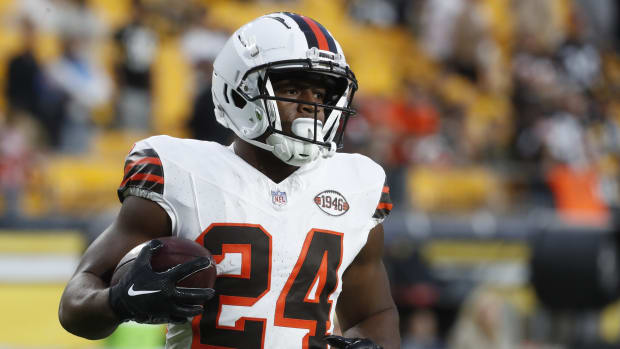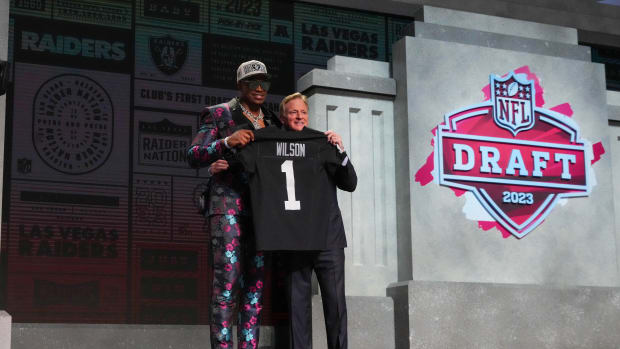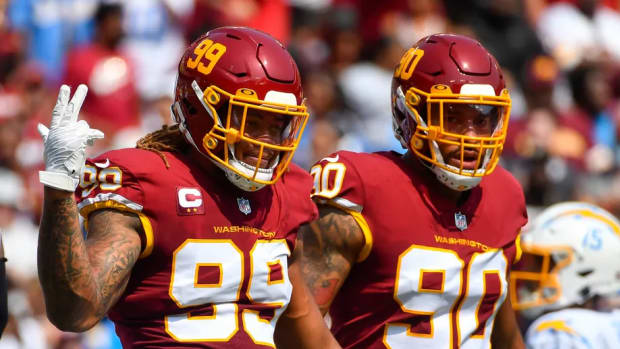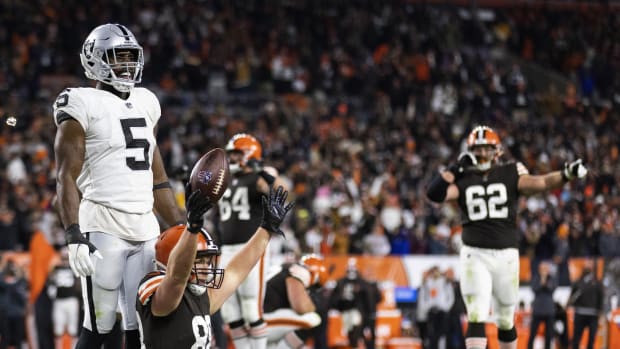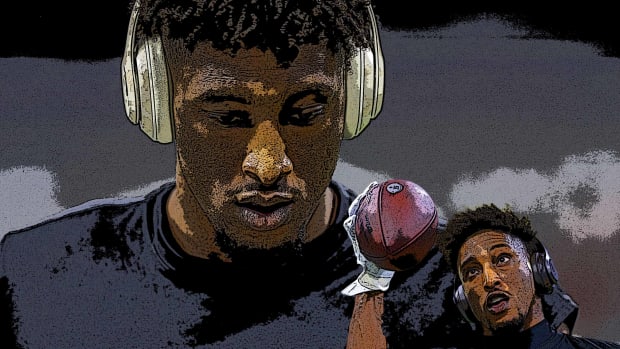The 2023 Eagles Are Making the Plunge
To understand the Tush Push, start with the league’s most valuable backside. Jalen Hurts’s lower half isn’t like most lower halves. His legs extend from his midsection like sequoias that are the envy of their forest, fortified by a lifetime in sports and his high school hobby of powerlifting.
[ Year in Review: From LeBron to Coco, see who made their mark in 2023 ]
Hurts squats more than 600 pounds and could, according to those who train him, surpass 750 if he focused solely on strength. His coaches find his lower half more impressive than his arm, which can chuck footballs country miles. If that lower half isn’t the strongest among NFL quarterbacks, it’s in the top three.
There’s no scarier sight for defenses in 2023. The Eagles face a third- or fourth-and-short. They pack in together at the line, as Hurts scans the defense. The ball snaps. He moves, inching ahead, behind one of the NFL’s best offensive lines. When his movement stops, help arrives, in the form of one or two teammates lined up behind him whose sole goal is to target his buttocks and, well, push, as hard as possible.
Last year the Eagles dialed up their bodies-on-top-of-bodies invention 41 times during the regular season and made either a first down or touchdown on 37 of those attempts. They also deployed six in Super Bowl LVII and had six conversions, two of which were TDs, that gave Philly a chance to win. The Tush Push is so ruthlessly effective that it has earned multiple nicknames: It has also been called the Brotherly Shove, the Rump Bump and the Two-Cheek Sneak. (You could also go with the Seat Cheat or Can-Do; for our money, the moniker should be Baby Got Back–ed, in honor of Sir Mix-a-Lot.)

Philly lost the Super Bowl but won the short-yardage trench battles.
Adam Bow/Icon Sportswire/Getty Images
But there’s more to the play than a quarterback’s incredibly strong seat and some clever branding. It looks like a simple display of brute force, combining the bluntness of a traditional QB sneak with the irresistible force of a 30-car pileup. But the most dominant play in today’s NFL was made possible by a cycle of rule changes, coaching innovations and cross-sport pollination that stretches back nearly two decades.
“We took a QB sneak, already a high-success-rate play, and we made it damn near unbeatable,” says one Eagles staffer. “It’s simplistic. But it’s innovative—because there’s a lot of technique to it.”
In the fall of 2005, Nick Sirianni, then 24, happened to be watching USC–Notre Dame on TV. One play stuck deep in his brain. Notre Dame led, 31–28, but the Trojans drove down the field and pushed the ball inches from the goal line. USC’s Matt Leinart took the snap and dived forward on a traditional QB sneak, but Fighting Irish defenders halted his momentum immediately. One hit turned Leinart in nearly a full circle—but as he spun running back Reggie Bush beelined forward, put his hands on Leinart’s lower back and shoved the QB into the end zone for the winning score.
The Bush Push was illegal the millisecond Bush’s hands touched Leinart’s back: In 2005 both college football and the NFL outlawed any direct aid to ballcarriers. Bush was not f lagged, though, and, decision-makers at both levels soon changed their minds. In ’06 the NFL removed language in its rule book that forbade pushing runners. Members of its competition committee have said that the impetus for the change was to remove a difficult judgment call from a referee’s responsibilities—it was often impossible to discern whether a player had sprinted forward to block or push a teammate.
The quarterback sneak has existed as long as football, but innovations have happened slowly—perhaps because the play has always been effective. In the 1980s and ’90s, San Francisco’s West Coast offense, with its sped-up tempo, tasked Joe Montana and Steve Young with more sneaks than ever, reasoning that the nature of their offense made defenses more tired. Montana notably scored on a sneak in the 49ers’ first Super Bowl victory (XVI, over the Bengals). Young clinched another Super Bowl berth in the ’94 season with a sneak-score against Dallas in the NFC championship.
Tom Brady elevated the QB sneak to an art form: He retired with 124 short-yardage conversions, the most in NFL history, and the second-highest conversion rate (90.5%, second only to David Garrard’s 91.1% among QBs with at least 50 tries). Longtime Patriots offensive line coach Dante Scarnecchia attributes that success to many factors: play design, variations and Brady’s innate ability to decide, in a split second, which gap to dive into. He almost always picked at the last moment, after training all season to identify “natural entry points” in A gaps on both sides of the center or B gaps between guards and tackles.

When Sirianni got the Philly job, the QB in place was perfect for a play that had been in the back of his mind for more than a decade.
Kevin Jairaj/USA TODAY Sports
As teams tried to mimic Brady, the volume of quarterback sneaks rose, from 47 in 2017 to 87 the next year. When Sirianni became the Eagles’ head coach in ’21, he inherited Hurts from the previous draft class. One area that his staff of innovative assistants targeted as ripe for improvement was the classic sneak. Some Philly staffers say the twist started in the brain of then offensive coordinator Shane Steichen; others believe it originated from more of a group effort. Regardless, all contributed to the design and its evolution.
The Eagles debuted a version in the 2022 season opener while clinging to a three-point fourth-quarter lead against the Lions and facing a critical fourth-and-1 at the Detroit 40-yard line. They lined up for a sneak, with tight end Dallas Goedert behind Hurts in the backfield. They snapped the ball and … there it was … the shove. Hurts picked up the first down, and football was introduced to the play the league would spend the next two seasons debating, celebrating, studying, mocking and imitating. It seemed new—but Philly had been working on it for longer than anybody knew.
Philadelphia started with a single pusher before deploying a Triple I formation Tush Push against Arizona in October 2022. The success of that twist led to the permanent addition of a second pusher. With two additional hands, plus what the Eagles call their offensive line’s “leverage game,” the team knew what soon became obvious to the rest of the NFL: Nobody could stop it.
Long before the debut of the Tush Push, Ted Rath, the Eagles’ director of sports performance, saw the staff diagramming a strange, new short-yardage play. It reminded Rath of a rugby scrum, which reminded him of a Scotsman he had met when he was working for the Dolphins in 2016: Richie Gray, a longtime coach in the Scottish professional rugby union and for several national teams. If you haven’t heard of Gray or his influence on professional football, that’s intentional. He rarely gives interviews, especially to U.S. outlets or about his work in the NFL. But Gray has developed and taught his own brand of “tackle methodology” and has been a consultant to NFL teams and individual players for years. One protégé, Christian Wilkins, set a league record for defensive tackles with 98 stops for Miami last season.
In 2015, while Gray was coaching South Africa’s national rugby team in the World Cup, a friend called before the Springboks’ semifinal match against New Zealand. This friend wanted to connect Gray to Dave Puloka, the Dolphins’ head of strength and conditioning, who wanted to learn more about Gray’s brand of performance coaching.
“The NFL is two things,” Gray says he realized when he began working with Miami the following spring. “Block and tackle.” Seven years later, the Eagles invited Gray to take a look at the play people were comparing to a rugby scrum. “I want your genuine opinion on how you would break it down defensively,” offensive line czar Jeff Stoutland said to him. “Or if there’s anything you’d add to the attack.”
Gray studied film of the Tush Push, evaluating every player on both sides of the ball, looking at things like presnap alignments and body positions, in every frame of every play. With the Eagles he noticed an organizational alignment, a collective push to brainstorm and innovate and embrace daring in a copycat league. He told the locker room what is now clear to the rest of the NFL. Action will always beat reaction. The only way to defend this concoction would be for defensive players to link—but that’s unheard of in the NFL. “Guys, you cannot stop organized mass,” Gray said. “This is going to be unstoppable.”
As one of the most respected offensive line coaches in NFL history, Scarnecchia watched the Tush Push overwhelm pro football after he retired from the Patriots in 2020 and wondered about the rugby ties. He also knew what every football player was taught at one of their first practices: get leverage. Blockers are taught to drop their bodies so their pads are lower than their opponent’s shoulders, to drive defenders backward and upward. “Hit and lift” is the preferred technique. Low man wins. “And, usually, the process of inertia takes over,” Scarnecchia says.
Gray is intentionally evasive about the specific techniques he taught the Eagles. But don’t discount their impact on making Hurts the new king of quarterback sneaks. “There’s things that were discussed, little things; all remain behind closed doors,” Gray says.
It all leads Scarnecchia to ask: “Did the Eagles invent the best way possible to run a quarterback sneak?”
Philadelphia’s All-Pro center, Jason Kelce, recently mentioned Gray’s visit on his podcast—some “Scottish guy” and his “organized mass.” All centers, whether currently employed or retired, watch the Tush Push with mixed emotions. They wince at the pain Kelce must feel at the bottom of all that humanity. And they marvel at Philly’s ability to evolve the most basic of football plays. Like Robbie Tobeck, a 13-year veteran of Atlanta and Seattle who retired in 2007. He played only one season after the push rule change, never saw a quarterback squat for anything and still was involved in various attempts to innovate the sneak.
In other words, the Eagles weren’t the first to scour for another way. They were, instead, the best at figuring one out. And the purists who describe a simple push of a tush as an abomination, Tobeck argues, miss the point. Other teams have adopted their own versions of the play without the same rate of success. Some of those imitators have wide-bodied quarterbacks. Some have elite runners at the position. Some have elite offensive lines. But none are as ideally tailored for the play as Philadelphia.
A combination of factors separate the Brotherly Shove from the knockoffs: the tush being pushed (“Brady couldn’t squat 600 pounds,” Scarnecchia says), a center among the NFL’s smartest and most durable, and the bulk lined up next to him on both sides. (The Eagles’ O-line starters—Kelce, Landon Dickerson, Lane Johnson, Cam Jurgens and Jordan Mailata average 324 pounds.) Tobeck argues this team would sneak effectively even without the push.

Hurts had a pair of 1-yard touchdowns in last October’s game agains the Cardinals.
Joe Camporeale/USA TODAY Sports
Conviction matters, too. Like in Week 7 when the Eagles called for a Tush Push on fourth-and-1 at their own 26-yard-line, an unthinkable decision even two seasons ago—and it worked. The conversion, in that and similar situations, becomes ancillary, because the dynamic of power demonstrated, force applied and wills drained on opposing sidelines, changes games, seasons and legacies, often by message alone.
Dan Quinn, the Cowboys’ defensive coordinator, is speaking late one night in early November, three days after Dallas lost one of the wildest games of the season to the Eagles. Hurts had tied the game with a push-plunge, his seventh rushing touchdown of the year—and sixth with two teammates at his back.
Quinn is busy trying to solve an impossible riddle. He understands Gray’s notion that the Eagles cannot really be countered without rule tweaks. That won’t stop him. The Eagles, he says, present a “gigantic” left side of their offensive line. Does that make the right side more vulnerable? His instinct tells him no. But perhaps there’s a combination to uncover, a way to win the shoulder battle and simultaneously defend the higher plane. He notes that a package of game film is currently somewhere over the Atlantic Ocean, en route to his own rugby consultant. “I’m anxiously waiting to hear back,” he says.
Teams have tried placing their best players at the center of the pileup; Quinn attempted that primarily with 265-pound defensive end DeMarcus Lawrence and with 245-pound edge rusher Micah Parsons. He also sent defenders around the line, looping toward the QB, or leaping over O-linemen, intent on punching at the ball as they descended. Since Hurts generally is shoved into the A gap to his left, Quinn’s jumpers went over the left guard. But none could land a punch. “They really get off the ball,” he says of the Eagles. “We may have to link off the snap. That’s really the only way. And it’s way more challenging than it sounds.”
Solving the riddle of the Tush Push could require mind-boggling defensive creativity. Like using offensive linemen on defense, since they’re used to blocking techniques and could apply them in reverse. Gray, the Eagles’ rugby expert, says there’s another possibility. The same techniques the Eagles use to make the Tush Push unstoppable could be deployed by the defensive linemen across from them.
Most in the NFL believe the Tush Push has an expiration date, perhaps after this season. League officials are expected to discuss the play in the off-season, after heavy debate last spring failed to reach definitive conclusions. On-field officials have been tasked with watching for illegal formations, cut blocks and spearing within all variations.
Experts like Scarnecchia expect the NFL to return to a pre–Bush Push universe, outlawing the shove. That change won’t eliminate the Eagles’ blocking techniques. “Personally, Scarnecchia says, “I’d just let it go, let them continue, until people figure it out.”
Gray hears this in Scotland and laughs a satisfying laugh. If the shove becomes illegal, “I guarantee the Eagles are going to come up with something else.”

































